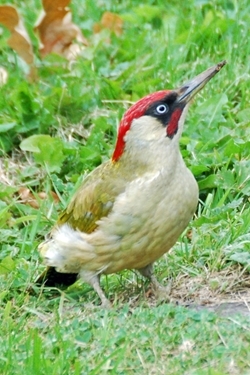Green woodpecker
 I often get the best views of the fairly elusive green woodpecker during the late summer and autumn months. Most of the year, you only catch a glimpse of the colourful yellow and green backside of the bird as its undulating flight takes it away to the safety of some distant clump of trees. However, at this time of year I often observe it feeding on my rather unkempt lawn, which is ideal as it hosts numerous ant colonies, perfect for green woodpeckers to dine on their favourite food.
I often get the best views of the fairly elusive green woodpecker during the late summer and autumn months. Most of the year, you only catch a glimpse of the colourful yellow and green backside of the bird as its undulating flight takes it away to the safety of some distant clump of trees. However, at this time of year I often observe it feeding on my rather unkempt lawn, which is ideal as it hosts numerous ant colonies, perfect for green woodpeckers to dine on their favourite food.
Come October, they turn their attention to fallen apples in my garden – admittedly, until recently not something I had realised that they ate, although I suppose they could be taking grubs from within the apples.
Green woodpeckers, unlike other woodpeckers, spend most of their time hunting out ants and various grubs on the ground rather than in trees. They have a wonderfully adapted tongue, which is extremely long and is coated with a sticky secretion produced by enlarged salivary glands. It also has a broadened tip to the tongue, which helps it probe deep into ant nests to take adult ants and their larvae.
This tongue is astonishing, as it is so long that it has to coil behind the skull, over the eyes and into the right nostril in order to fit inside the bird’s head. It measures in at ten centimetres (3.9 inches), which if we had a tongue of the same relative dimensions, would stretch out at around half a metre (1.6 feet).
Green woodpeckers have a wonderfully distinctive “laughing call”, which has given rise to its most commonly used country name of “Yaffle” – which is actually in the Oxford English Dictionary, used to describe the bird’s yaffling call. When I was growing up in rural Worcestershire, many a local farm worker or gamekeeper would superstitiously announce that “rain is on the way”, if they heard the yaffling call of a green woodpecker, giving rise to another country name of rain-bird.
Although they are mostly a sedentary species, green woodpeckers have slowly expanded their range in Britain, many believe due to a warming climate, breeding for the first time in Scotland in 1951 and continuing to move slowly northwards. However, they are still absent from Ireland (as are all woodpeckers) and the Isle of Man, and only colonised the Isle of Wight in 1910, which does seem to demonstrate a reluctance to cross water.
Have you ever wondered how woodpeckers can constantly peck away at speed without damaging their brains? Well, in a clever design, a woodpecker’s beak is separated from its skull by flexible, spongy cartilage that serves as a shock absorber.
Whilst a graduate student, budding designer Anirudha Surabhi suffered from concussion after falling from his bike, despite the fact that he was wearing a helmet. So, he decided to try to build a better bike helmet for his final student project.
It was not long before he found out about the woodpecker’s unique shock absorber system and so he set out to see if he could duplicate this design, ending up with a special type of latticed cardboard liner that employs a hexagonal honeycomb structure. Air pockets contained in the structure help protect the wearer’s head in the event of a crash. Tests show that the helmet absorbs three times as much force as traditional helmets and is also 15% lighter.
So the next time you are out on a bike ride, perhaps with your family, and you hear the yaffling sound of a green woodpecker, you can smile to yourself in the knowledge that it has helped to keep your family safe. Mind you, it might also be time to head back home, as most probably rain is on the way!
Peter Thompson
Advisory
Read more from Peter Thompson at his blog.

Download Peter Thompson's essential 26-page book, featuring beautiful photography and detailed profiles of Britain's wildlife
Download FREE >